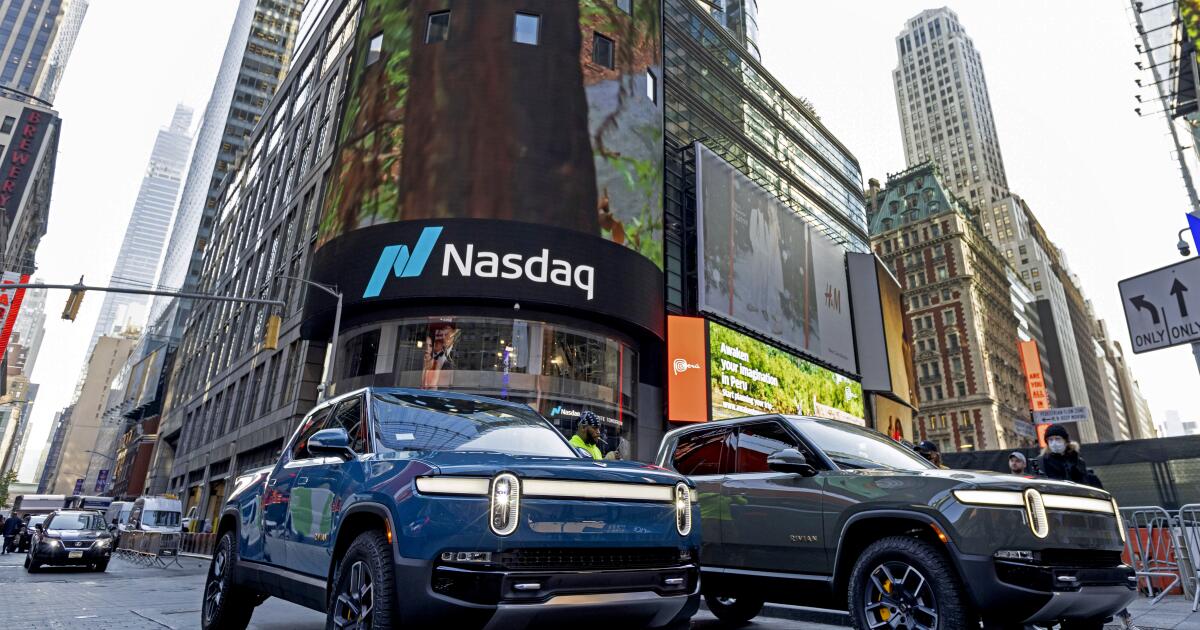Business
Column: The depressing fall of Sports Illustrated reveals the real tragedy of AI

Quick, name five classic American magazines.
Did you say Sports Illustrated? I did. And I’m not even a sports guy. But if you’re of a certain age, you know Sports Illustrated. Along with, say, People, Time and National Geographic, it has long lined the dentist offices, neighbors’ doormats and coffee tables of your life. It’s an institution. At one point, it boasted 3 million subscribers. It’s won numerous awards and accolades. The evening news would do whole segments about its swimsuit issue.
Today, it’s pumping out third-rate articles by AI-generated writers in a darkening corner of the internet. It’s a stunning fall for one of the great icons of American sports journalism. So what happened? How did such a celebrated publication get here? The answers point us to one of the most pressing — and unlikely — dangers posed by the ongoing AI boom.
First, the facts: On Monday, the tech and culture site Futurism published an expose that revealed Sports Illustrated was publishing bizarre and badly written articles attributed to authors that didn’t exist.
The reporters traced the fake authors’ headshots to a website that sells AI-generated images, and sources told them that the stories they allegedly wrote were produced by AI, too. “The content is absolutely AI-generated,” one said, “no matter how much they say that it’s not.” When contacted, Arena Group, Sports Illustrated’s publisher, deleted all of the suspicious content and, in a statement, denied it was created by AI. Arena blamed the mess on AdVon, a third-party company hired to produce content.
The saga has been heatedly discussed by journalists and media watchers, and lamented by onetime fans of the iconic brand. Generative AI very much remains a hot-button topic, and the question of whether it’s ethical — or a good idea — to use AI has driven much of the conversation.
But it’s worth backing up and looking at the bigger picture here, and the conditions that led to the use of such sketchy AI in the first place. Because this story is as much about bad management, sheer laziness and how relentlessly profit-seeking corporate management can erode our cultural institutions as it is about any given technology.
Sports Illustrated was already in dire shape long before Arena brought in the AI. Amid economic challenges that confront all print media, the magazine’s revenue and subscriber base declined over the 2010s. It repeatedly downsized, switched from a weekly to a monthly publication schedule and was sold by its owner, Time Inc., to a company called Authentic Brands Group, or ABG, which is in the business of inking lucrative licensing deals. ABG then sold a 10-year license to publish Sports Illustrated to our new friends at Arena Group.
As a result of this arrangement, Sports Illustrated branding is now showing up both on dietary supplements and on thousands of hastily produced blog posts. After all, on the publication side of the business, “Arena’s options for generating revenue are somewhat limited, encouraging a daily churn of articles,” as the New York Times reports. “Hundreds of sites dedicated to individual teams — helmed by non-staff writers paid small sums — were created with little oversight and diluted what it meant for ‘Sports Illustrated’ to write something.” Arena has continued to fire editors and staffers, while enforcing weekly quotas of article production. (On the licensing side, business is booming — ABG says it has doubled Sports Illustrated’s earnings. That’s a lot of Sports Illustrated-brand diet pills. It also launched an online SI-branded casino in 2021.)
In other words, Sports Illustrated is run by not one but two vampiric entities with markedly little interest in the magazine’s erstwhile core mission — you know, the thing that made it so beloved in the first place, doing good sports journalism — and every interest in maximizing profits at every opportunity. And they have squeezed the lemon until it was dry.
And here’s where the AI comes in.
Not as a tool deployed by forward-looking executives eager to embrace the future, but as a last-ditch effort to extract the final bits of value from the pieces of something that’s already broken. Sports Illustrated has already slashed full-time staff, spun up a content mill with freelancers pumping out content for a fraction of the price, and let editorial standards sink into the gutter. The AI play is an arrow out of the same quiver.
It’s increasingly clear that to those in the content generation business — worth noting maybe that the original founders of Sports Illustrated would probably bristle at such a term — AI has become popular as a relatively cheap, wholly unimaginative way to attempt to generate value with the lowest amount of effort or investment.
To wit: This year has already seen a rash of AI scandals in the media world. The staffers of G/O Media, the publisher of popular sites including Gizmodo and the Onion, revolted after their publisher deployed generative AI to produce bland, error-ridden content. The once-venerable tech site CNET was caught — also by Futurism, incidentally — publishing AI-generated stories without disclosing them as such. BuzzFeed controversially announced that it would be using AI to generate posts like its trademark quizzes, and then disbanded its human-staffed News division.
Most recently, Gannett, the publisher of USA Today and many other newspapers, was accused of publishing AI-generated review content — curiously, it too blamed AdVon, the same company Sports Illustrated fingered in its statement on the matter.
All of these stories have one major thread in common — each of the media institutions in question had been facing economic challenges, and was run by an owner whose interest was not in producing a quality publication but gaming the algorithm to maximize profits while minimizing staff. As with SI, all were in dire straits before AI entered the equation.
G/O Media, formerly GMG Media, formerly Gawker Media, had been bankrupted by a malicious lawsuit funded by Silicon Valley titan Peter Thiel, repackaged and sold to Univision, then sold again to a private equity firm, Great Hill Partners. In a push to maximize revenues, Great Hill set about firing staffers, introducing spammy autoplay ads and asking staff to write more slideshows, which require readers to click more times than regular stories. In short, a nakedly profit-seeking agenda — one that came at the direct expense of both staff and readers — was in place long before the publisher started mucking around with AI.
When it finally did, notably publishing an article whose sole purpose was to list the “Star Wars” movies in order and yet got the order wrong — it caused an uproar.
Similarly, CNET has been hurting for years. Once a powerhouse of tech media, it was acquired by CBS for $1.8 billion in 2008, then was sold to a little-known private equity company based in South Carolina called Red Ventures. The Verge describes its business model as “straightforward and explicit: it publishes content designed to rank highly in Google search for ‘high-intent’ queries and then monetizes that traffic with lucrative affiliate links.” AI was used, it is believed, to streamline and maximize that process.
Both CNET and G/O are now owned by private equity firms, and much has been written about what a disaster it’s been for journalism to hand such companies the keys — one academic paper even quantified the damage. Which has been considerable.
As a journalist, all of this depresses me — I worked for Gizmodo for a bit, and was once an avid reader of Gawker, Deadspin and the AV Club, all of which have been gutted. BuzzFeed News won a Pulitzer and was widely loved. Sports Illustrated was a legend.
And look, things change. Cultural institutions evolve, fade, die out. Not every magazine needs to exist forever. But it is a bummer when an otherwise popular, viable, even beloved cultural institution is killed off — while there’s a team that’s working overtime at the helm that wants to keep the lights on — because a Wall Street firm or an adventuring licensing company can increase earnings at the margins by cutting out its heart.
The tragedy of AI is not that it stands to replace good journalists but that it takes every gross, callous move made by management to degrade the production of content — and promises to accelerate it.
If journalists are outraged at the rise of AI and its use in editorial operations and newsrooms, they should be outraged not because it’s a sign that they’re about to be replaced but because management has such little regard for the work being done by journalists that it’s willing to prioritize the automatic production of slop.
AI does not emerge from a media company’s innovation lab but from a handshake deal with a shady third-party company. It’s a hail Mary move that aspires to take the place of formulating a real plan to turn a business around — a future-shaped Get Out of Jail Free card for business leaders confronting bad times. And it’s almost certain to fail to deliver.

Business
Albertsons to pay $3.9 million over allegations it overcharged, lied about weight of groceries

Grocery titan Albertsons will pay $3.9 million to resolve a civil law enforcement complaint alleging that it ripped off customers at hundreds of its Vons, Safeway and Albertsons stores in California, authorities said Thursday.
According to the complaint, groceries sold by Albertsons Cos. — including produce, meats, baked goods and other items — had less product in the package than indicated on the label. The company also is accused of charging customers prices higher than its lowest advertised price.
“False advertising preys on consumers, who are already facing rising costs, and unfairly disadvantages companies that play by the rules,” L.A. County Dist. Atty. George Gascón said. “This kind of corporate conduct is especially egregious when it comes to essential groceries, as Californians rely on accurate advertised prices to budget food for their families.”
The case was filed in Marin County Superior Court in partnership with the consumer protection units of the district attorney’s offices of Los Angeles, Marin, Alameda, Sonoma, Riverside, San Diego and Ventura counties.
The settlement will be divided among the seven counties and used to support future enforcement of consumer protection laws, according to the Marin County district attorney’s office. None of the money will be paid back to consumers.
The fine comes just over a year after the same company was ordered to pay $3.5 million for selling expired over-the-counter drug products. The company is also currently fighting a federal antitrust lawsuit that seeks to block its planned merger with grocery giant Kroger Inc.
Albertsons Cos. operates 589 Albertsons, Safeway and Vons stores in California. The company did not admit wrongdoing. It cooperated with the investigation and has taken steps to correct the violations, according to the L.A. County district atttorney’s office.
In a statement on the settlement, the company said it takes the matter seriously and is committed to ensuring its customers can shop with confidence.
“We have taken steps to ensure our price accuracy guarantee is more visible to customers by posting signage at multiple locations at the front of our stores,” the company stated. “We have conducted additional comprehensive training for associates to reinforce the importance of price accuracy and customer transparency. Additionally, we have enhanced price tracking systems to better ensure real-time accuracy at stores.”
Prosecutors in the lawsuit alleged that the company failed to implement a price accuracy policy ordered by a court in 2014.
The policy requires that customers who are overcharged for an item either receive the item for free or receive a $5 gift card, depending on which option is worth more. It is designed to encourage customers to immediately report false advertising.
Under the judgment reached Thursday, the grocery giant must implement this policy and ensure staff are properly trained to place accurate weight labels on products.
The serial overcharging was discovered through inspections by Marin County’s Department of Agriculture, Division of Weights and Measures and its counterparts across the state.
“We could not have achieved this result without the outstanding work of our Weights and Measures inspectors as well as vigilant consumers,” said Deputy Dist. Atty. Andres Perez, who prosecuted the case for Marin County.
For the next three years, Albertsons Cos. is required to hire an independent auditor to ensure it is complying with the terms of the judgment.
Business
Disney faces class action lawsuit over employee data breach

Walt Disney Co. has been hit with a class action lawsuit accusing the Burbank-based entertainment giant of negligence, breach of implied contract and other misconduct in connection with a massive data breach that occurred earlier this year.
Plaintiff Scott Margel submitted the complaint on Thursday in Los Angeles County Superior Court against Disney and Disney California Adventure. The 32-page document also accuses the company of violating privacy laws by not doing enough to prevent or notify victims of the extent of the leak.
The class members, estimated to number in the thousands, are described in the complaint as individuals who gave “highly sensitive personal information” to Disney in connection with their employment at the company — information that was allegedly compromised in the breach.
Representatives of Disney did not immediately respond Friday to The Times’ request for comment.
The lawsuit cites an article published in September by the Wall Street Journal, which reported that a hacking group known as NullBulge publicly released data spanning more than 18,800 spreadsheets, 13,000 PDFs and 44 million internal messages sent via the workplace communication platform Slack.
According to the Journal, the compromised Slack messages contained sensitive information belonging to Disney cruise employees, including passport numbers, visa details, birthplaces and physical addresses; at least one spreadsheet listed the names, addresses and phone numbers of some Disney Cruise Line passengers. The publication later reported that Disney planned to stop using Slack after the breach.
The plaintiff and class members “remain, even today, in the dark regarding which particular data was stolen, the particular malware used, and what steps are being taken, if any, to secure their [personal information] going forward,” the complaint reads.
The plaintiff and class members “are, thus, left to speculate as to where their [data] ended up, who has used it and for what potentially nefarious purposes.”
In July, NullBulge said that it had leaked roughly 1.2 terabytes of Disney data in rebuke of the company’s treatment of artists, “approach to AI” and “pretty blatant disregard for the consumer.” The self-proclaimed hacktivists told CNN that they were able to penetrate Disney’s system thanks to “a man with Slack access who had cookies.”
A Disney spokesperson said in a statement at the time that the company was “investigating this matter.”
Margel is demanding that Disney take steps to reinforce its security system and educate class members about the risks associated with the breach. The plaintiff is also seeking unspecified damages and a jury trial.
Business
Rivian cuts production forecast, citing supply chain issue; its stock dips

Electric vehicle maker Rivian saw its shares dip Friday after the Irvine-based company cut its production targets amid ongoing supply issues.
Citing a shortage of a component used to build its electric pickups, sport utility vehicles and vans, Rivian said production could drop as much as 18% this year at its lone U.S. assembly plant.
Rivian did not specify the part that is in low supply but noted that the shortage has become more acute in recent weeks.
The company now forecasts its full-year production will be between 47,000 and 49,000 vehicles, down from an earlier estimate of 57,000. During the most recent quarter, Rivian produced 13,157 vehicles and delivered 10,018, falling short of analysts’ expectations.
Shares of Rivian ended the day at $10.44, down 3.2%. The company’s stock has been battered since the start of the year, falling by more than 50% amid underwhelming financial reports. In the second quarter this year, Rivian posted a net loss of $1.46 billion compared with a loss of about $1.12 billion during the same period a year earlier. The company is scheduled to announce its third-quarter earnings next month.
Rivian received a lifeline in June when Volkswagen agreed to a massive investment in the company that is expected to total $5 billion. Rivan has nonetheless continued to struggle in the face of dropping demand for electric vehicles and other supply chain issues that forced the company to pause its production of commercial vans for Amazon.com in August.
Early this year, the automaker announced a 10% cut in its workforce that sent stocks plummeting 25% in one day. The pool of interested wealthy buyers who don’t already own an electric vehicle is shrinking, analysts said, while the broader market weighs the advantages and feasibility of switching to electric.
The average car buyer is not likely to be able to afford a Rivian vehicle, and concerns remain about charging infrastructure and the distance vehicles can drive on a single charge. Rivian’s R1T electric pickup truck starts at around $70,000; its R1S SUV starts at nearly $75,000.
With sleek design and outdoorsy features, Rivian’s vehicles garnered much attention from analysts and attracted investors such as Amazon and Volkswagen. The company exceeded expectations during its initial public offering of stock in 2021, ending its first day of trading valued at nearly $88 billion.
The production issues announced this week could get in the way of Rivian’s goal of achieving positive gross profits by the fourth quarter of this year. According to analysts, the company’s gross margins are expected to remain in negative territory in the final three months of 2024.
-
/cdn.vox-cdn.com/uploads/chorus_asset/file/25439572/VRG_TEC_Textless.jpg)
/cdn.vox-cdn.com/uploads/chorus_asset/file/25439572/VRG_TEC_Textless.jpg) Technology3 days ago
Technology3 days agoCharter will offer Peacock for free with some cable subscriptions next year
-

 World2 days ago
World2 days agoUkrainian stronghold Vuhledar falls to Russian offensive after two years of bombardment
-

 World3 days ago
World3 days agoWikiLeaks’ Julian Assange says he pleaded ‘guilty to journalism’ in order to be freed
-

 Technology2 days ago
Technology2 days agoBeware of fraudsters posing as government officials trying to steal your cash
-

 Virginia4 days ago
Virginia4 days agoStatus for Daniels and Green still uncertain for this week against Virginia Tech; Reuben done for season
-

 Sports1 day ago
Sports1 day agoFreddie Freeman says his ankle sprain is worst injury he's ever tried to play through
-

 Health14 hours ago
Health14 hours agoHealth, happiness and helping others are vital parts of free and responsible society, Founding Fathers taught
-

 News14 hours ago
News14 hours agoLebanon says 50 medics killed in past three days as Israel extends its bombardment















